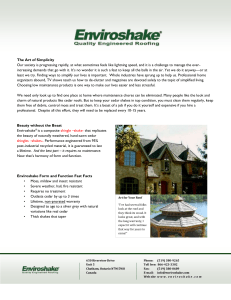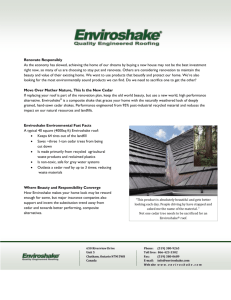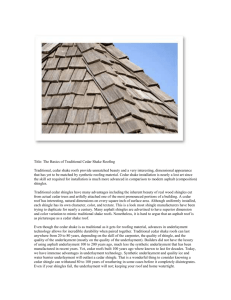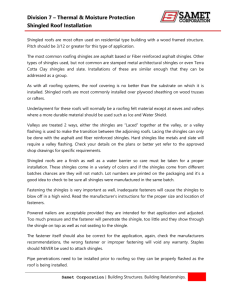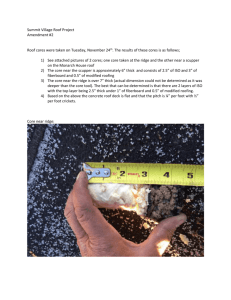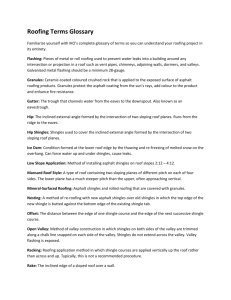Wood shingles and shakes are made from cedar, redwood, southern
advertisement
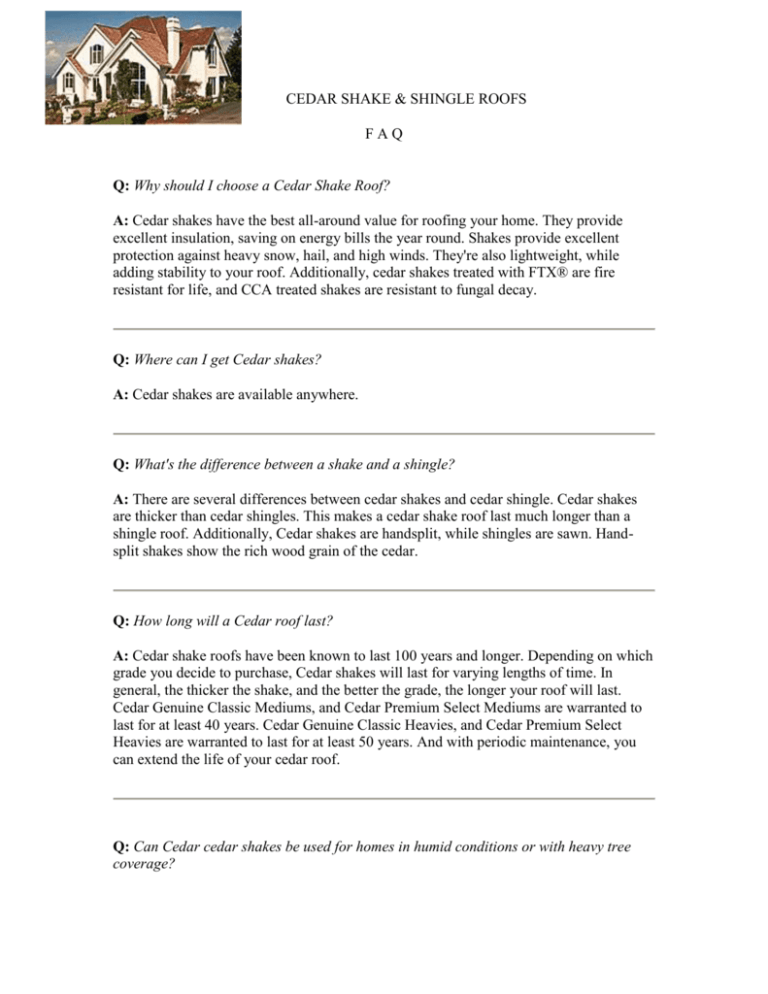
CEDAR SHAKE & SHINGLE ROOFS FAQ Q: Why should I choose a Cedar Shake Roof? A: Cedar shakes have the best all-around value for roofing your home. They provide excellent insulation, saving on energy bills the year round. Shakes provide excellent protection against heavy snow, hail, and high winds. They're also lightweight, while adding stability to your roof. Additionally, cedar shakes treated with FTX® are fire resistant for life, and CCA treated shakes are resistant to fungal decay. Q: Where can I get Cedar shakes? A: Cedar shakes are available anywhere. Q: What's the difference between a shake and a shingle? A: There are several differences between cedar shakes and cedar shingle. Cedar shakes are thicker than cedar shingles. This makes a cedar shake roof last much longer than a shingle roof. Additionally, Cedar shakes are handsplit, while shingles are sawn. Handsplit shakes show the rich wood grain of the cedar. Q: How long will a Cedar roof last? A: Cedar shake roofs have been known to last 100 years and longer. Depending on which grade you decide to purchase, Cedar shakes will last for varying lengths of time. In general, the thicker the shake, and the better the grade, the longer your roof will last. Cedar Genuine Classic Mediums, and Cedar Premium Select Mediums are warranted to last for at least 40 years. Cedar Genuine Classic Heavies, and Cedar Premium Select Heavies are warranted to last for at least 50 years. And with periodic maintenance, you can extend the life of your cedar roof. Q: Can Cedar cedar shakes be used for homes in humid conditions or with heavy tree coverage? A: Yes. With preservative we seal Cedar shakes from fungal decay associated with prolonged wet and humid conditions. This vacuum pressure-impregnation process protects the wood from the elements, and comes with a 30-Year Limited Warranty. Q: How much do Cedar shakes cost in comparison to other materials on the market? A: Genuine Cedar shakes are surprisingly affordable, which makes them an excellent value when compared to the cost, and especially the questionable performance of tile, cement composites, and asphalt. Warranted for up to 50 years against material defects, Cedar remains the genuine choice for its aesthetic charm and proven durability. Q: What type of maintenance does a Cedar shake roof require? A: Cedar shakes are the only roofing material made in which periodic maintenance will prolong the life of your roof. With minimal effort, you can remove leaves, twigs, etc. from your cedar roof. Q: What types of warranties does Cedar offer? A: Cedar Genuine Classic Mediums, and Cedar Premium Select Mediums are warranted from material defects for 40 years. Cedar Genuine Classic Heavies, and Cedar Premium Select Heavies are warranted from material defects for 50 years. Q: Will a Cedar cedar shake roof increase the value of my home? A: Yes. Cedar shakes have always been the premium roofing material for finer homes. As a result, homes topped off with cedar can command a premium price. Wood shingles and shakes are made from cedar, redwood, southern pine and other woods; Wood shingles are machine sawn; shakes are handmade and rougher looking. A point to consider: Some local building codes limit the use of wood shingles and shakes because of concerns about fire resistance. Many wood shingles and shakes only have Class C fire ratings or no ratings at all. However, Class A fire ratings are available for certain wood shingle products that incorporate a factory-applied, fire-resistant treatment. What's the difference between a shake and a shingle? A: There are several differences between cedar shakes and cedar shingle. Cedar shakes are thicker than cedar shingles. This makes a cedar shake roof last much longer than a shingle roof. Additionally, cedar shakes are handsplit, while shingles are sawn. Handsplit shakes show the rich wood grain of the cedar. Choosing a contractor Buying a new roof system is an important investment. Before you spend your money, spend time learning how to evaluate roofing contractors. You should insist on working with a professional roofing contractor. National Roofing Contractors Association; NRCA wants to assist you in getting the kind of results you expect—a quality roof system at a fair price. All roofing contractors are not alike, and NRCA recommends that you pre-qualify roofing contractors to get the job done right the first time. The following guidelines will help you select a professional: Check for a permanent place of business, telephone number, tax identification number and, where applicable, a business license. Don't hesitate to ask a roofing contractor for proof of insurance. In fact, insist on seeing copies of his liability coverage and workers' compensation certificates. (U.S. workers’ compensation laws vary by state. Consult your state’s laws to determine workers’ compensation insurance requirements.) Make sure the coverages are in effect through the duration of the job. Many building and home owners have been dragged into litigation involving uninsured roofing contractors. Also, if a contractor is not properly insured, you may be liable for accidents that occur on your property. Check to see if the roofing contractor is properly licensed or bonded. Some states have specific licensing requirements, and others do not. Your state's Department of Professional Regulation or Licensing Board will have this information. In Virginia, the Department of Professional and Occupational Regulation (DPOR) may be contacted at (804) 367-8586 or http://www.state.va.us/dpor. Make sure the contractor is financially stable. A professional roofing contractor can provide current financial information about his company. Look for a company with a proven track record that offers client references and a list of completed projects. Call these clients to find out whether they were satisfied. Insist on a detailed, written proposal and examine it for complete descriptions of the work and specifications, including approximate starting and completion dates and payment procedures. Have the contractor list the roofing manufacturers with which his firm is a licensed or approved applicator. Most roof systems require special application expertise to achieve lasting quality. Have the contractor explain his project supervision and quality-control procedures. Request the name of the person who will be in charge of your project, how many workers will be required and estimated completion time. Check to see if the contractor is a member of any regional or national industry associations, such as NRCA. Being a member of industry associations demonstrates a commitment to professionalism. Call your local Better Business Bureau or Department of Professional Regulation to check for possible complaints filed against the contractor. For Northern Virginia, the Better Business Bureau may be reached at 202393-8000 or http://www.dc.bbb.org/. The Department of Professional and Occupational Regulation (DPOR) may be contacted at (804) 367-8586 or http://www.state.va.us/dpor. Carefully read and understand any roofing warranties offered, and watch for provisions that would void it. Choose a company committed to worker safety and education. Ask the contractor what type of safety training he provides for his workers and what industry education programs they have attended. The best roofing contractor is only as good as the workers who install the roof system. Keep a healthy skepticism about the lowest bid. If it sounds too good to be true, it probably is. Many fly-by-night contractors' below-cost bids seem attractive, but these contractors often are uninsured and perform substandard work. Remember, price is only one of the criteria for selecting a roofing contractor. Professionalism, experience and quality workmanship also should weigh heavily in your decision. Terms you should know Deck/sheathing: The surface, usually plywood or oriented strand board (OSB), to which roofing materials are applied. Dormer: A small structure projecting from a sloped roof, usually with a window. Drip edge: An L-shaped strip (usually metal) installed along roof edges to allow water run off to drip clear of the deck, eaves and siding. Eave: The horizontal lower edge of a sloped roof. Fascia: A flat board, band or face located at a cornice's outer edge. Felt/underlayment: A sheet of asphalt-saturated material (often called tar paper) used as a secondary layer of protection for the roof deck. Fire rating: System for classifying the fire resistances of various materials. Roofing materials are rated Class A, B or C, with Class A materials having the highest resistance to fire originating outside the structure. Flashing: Pieces of metal used to prevent the seepage of water around any intersection or projection in a roof system, such as vent pipes, chimneys, valleys and joints at vertical walls. Louvers: Slatted devices installed in a gable or soffit (the underside of eaves) to ventilate the space below a roof deck and equalize air temperature and moisture. Oriented strand board (OSB): Roof deck panels (4 by 8 feet) made of narrow bits of wood, installed lengthwise and crosswise in layers, and held together with a resin glue. OSB often is used as a substitute for plywood sheets. Penetrations: Vents, pipes, stacks, chimneys-anything that penetrates a roof deck. Rafters: The supporting framing to which a roof deck is attached. Rake: The inclined edge of a roof over a wall. Ridge: The top edge of two intersecting sloping roof surfaces. Sheathing: The boards or sheet materials that are fastened to rafters to cover a house or building. Slope: Measured by rise in inches for each 12 inches of horizontal run: A roof with a 4-in-12 slope rises 4 inches for every foot of horizontal distance. Square: The common measurement for roof area. One square is 100 square feet (10 by 10 feet). Truss: Engineered components that supplement rafters in many newer homes and buildings. Trusses are designed for specific applications and cannot be cut or altered. Valley: The angle formed at the intersection of two sloping roof surfaces. Vapor retarder: A material designed to restrict the passage of water vapor through a roof system or wall. SOURCES OF ADDITIONAL INFORMATION American Society of Home Inspectors 932 Lee Street, Suite 101 Des Plaines, IL 60016 (847) 759-2820 Cedar Shake & Shingle Bureau P.O. Box 1178 Sumas, WA 98295-1178 (604) 462-8961 Metal Construction Association 104 S. Michigan Ave., Suite 1500 Chicago, IL 60603 (312) 201-0101 National Association of Home Builders 1201 15th St. N.W. Washington, D.C. 20005 (202) 822-0200 National Association of the Remodeling Industry 4900 Seminary Road, Suite 320 Arlington, VA 22203 (703) 276-7600 NRCA PUBLICATIONS/SERVICES NRCA Consumer Advisory Bulletins 1. Guidelines for selecting a roofing contractor explains how to prequalify roofing contractors so that a job is done right the first time. 2. Roofing warranties discusses the importance of selecting a roof system based on a product's qualities and suitability, in addition to its warranty. 3. Maintenance: The Key to Long-Term Roof Performance addresses the benefits of having formal, long-term maintenance agreements with professional roofing contractors. Roofing Qualification Statement as suggested by NRCA is a form home and building owners should ask prospective roofing contractors to complete and submit with proposals. The form asks for information about contractors' companies, work in progress, references, finances and insurance. The NRCA Steep Roofing Manual presents guidelines for steep-slope roofing, including asphalt shingles, wood shakes and shingles, slate, and clay and concrete tile. It addresses application techniques, construction details, general roofing requirements and precautions. The NRCA Steep-Slope Roofing Materials Guide is a comprehensive, 230page report about steep-slope products, including asphalt shingles, fiber-cement roof components, metal roof components, clay tile, concrete tile, slate and synthetic roof components. It contains detailed descriptions, comparative data, manufacturer-reported wind and fire ratings, and code approvals. For a free NRCA catalog of publications and audiovisual programs or to purchase any of these publications, visit NRCA's publications and audiovisuals section or contact NRCA's Marketing Services Department at (800) 323-9545, (847) 299-9070 (outside the United States and Canada) or e-mail nrca@nrca.net. (800) USA-ROOF is a service offered by NRCA to help home and building owners locate professional roofing contractors in specific geographic areas. Owners are sent, free of charge, a computerized list of NRCA-contractor members sorted by zip code, a listing of local and regional NRCA affiliate organizations, and information that describes common roof systems and general roofing terminology. To receive this information, home and building owners should call 1 (800) USA-ROOF. Please allow at least two weeks for delivery. Lists of NRCA-contractor members in specific geographic areas, can be obtained from NRCA's Web site search for a member section. Contractors can be selected by state, area code or zip code. Certi-Label® Cedar Shakes Certi-Split® Hand-Split Shakes These shakes have split faces and sawn backs. Cedar logs are first cut into desired lengths. Blanks or boards of proper thickness are split and then run diagonally through a band saw to produce two tapered shakes from each blank. Available in Premium Grade (100% edge grain) or Number 1 Grade (Up to 20% flat grain allowed in each bundle). Certi-Sawn® Tapersawn Shakes These shakes are sawn both sides. Premium and Number 1 Grades are the most common. Premium Grade is 100% edge grain, 100% clear and 100% heartwood. Number 1 Grade allows up to 20% flat grain in each bundle. Number 2 and 3 Grades are also available. Certi-Split® Tapersplit Shakes Produced by hand, using a sharp bladed steel froe and a mallet. The natural shingle-like taper is achieved by reversing the block, end-for-end, with each split. Premium Grade only. Certi-Split® Straight-Split Shakes Produced by machine or in the same manner as tapersplit shakes except that by splitting from the same end of the block, the shakes acquire the same thickness throughout. Premium Grade only. Certigrade® Cedar Shingles Number 1 Blue Label® The premium grade of shingles for roofs and sidewalls. These top-grade shingles are 100% heartwood, 100% clear and 100% edge grain. Available in 16" or 18" or 24" lengths. Number 2 Red Label A good grade for many applications. Not less than 10" clear on 16" shingles, 11" clear on 18" shingles and 16" clear on 24" shingles. Flat grain and limited sapwood are permitted in this grade. Number 3 Black Label A utility grade for economy applications and secondary buildings. Not less than 6" clear on 16" and 18" shingles, 10" clear on 24" shingles. Number 4 Undercoursing A utility grade for undercoursing of double coursed sidewalls only. Not a roofing material and not to be used as a starter course for roofs. Pressure-Impregnated Treated Products Certi-label products can also be treated. Products are available either fire-retardant-treated OR preservative-treated. Special care must be taken to follow the treatment company’s recommended installation instructions. Certi-Guard® Fire-Retardant Treated Cedar Shakes and Shingles Premium and Number 1 Grades of Certi-Split shakes and Certi-Sawn shakes, and Number 1 Grades of Certigrade shingles are available pressure-impregnated with fire retardants. Certi-Guard products may be used for Class A, B and C roof systems. Contact the treatment company for treatment warranty information, accessory product requirements (including recommended fastener types) and application details for treated cedar material. Local code jurisdictions have additional information regarding applications in specific areas. Certi-Last® .40 CCA Preservative-Treated Cedar Shakes and Shingles Premium and Number 1 Grades of Certi-Split shakes and Certi-Sawn shakes, and Number 1 Grades of Certigrade shingles are available preservative-treated by pressure processes. This product is ideal in areas of high humidity. Specify the Certi-Last treating label for this extra protection. Contact the treatment company for treatment warranty information, accessory product requirements (including recommended fastener types) and application details for treated cedar material. Note: Cedar’s natural color varies as shown in these examples, yet without applying a paint or stain it will all weather to a beautiful gray. Certi-label Shakes In shake application spaced sheathing is usually 1 x 6 boards spaced on centers equal to the weather exposure (Table 4, Page 20) at which the shakes are to be laid - but never more than 7 1/2" for 18" shakes and 10" for 24" shakes on roof installations. When 1 x 4 spaced sheathing is installed at 10" on center, additional 1 x 4 boards must be installed (i.e. maximum allowable spacing is approximately 3 1/2" measured from edge to edge between the sheathing boards). Please note that the only solid sheet sheathing tested with shakes and shingles is plywood. Check with your local building official for plywood thickness/ dimensions. A solid deck is recommended in areas where wind-driven snow is encountered. Roofing felt system interlay between the shake courses is required whether the sheathing is spaced or solid. The felt interlay acts as a baffle that prevents wind-driven snow or other foreign material from entering the attic cavity during extreme weather conditions. The felt interlays also increase the roof’s insulating value. The felt system interlay forces water to the surface. Special care should be taken when installing the felt interlays over spaced sheathing to ensure that an effective baffle is formed (Figure 4). The felt should be applied over the top portion of the shakes and extend on to the spaced sheathing so that the bottom edge of the felt is positioned at a distance above the butt equal to twice the weather exposure. Certi-label Shake Application Shakes, like shingles, are normally applied in straight, single courses. The following application details (Figure 4) must be observed. 1. The starter course may be one or two layers of cedar shingles or shakes overlaid with the desired shake. A 15" shake is made expressly for starter and finish courses. 2. Butts of first course shakes should project 1 1/2" beyond the fascia and approximately 1" over the gable or rake end. 3. The CSSB recommends using an 18" wide strip of Type 30 roofing felt laid over the top portion of the shakes and extending on to the sheathing. (Check with your local building official for exact specifications in your area). The bottom edge of the felt should be positioned above the butt of the shake at a distance equal to twice the weather exposure. For example, 24" shakes felt extends up 14" onto the sheathing forcing water to the surface. 4. Spacing between adjacent shakes should be a minimum of 3/8" and a maximum of 5/8". 5. Shakes shall be laid with a side lap of not less than 1 1/2" between joints in adjacent courses. 6. Straight-split shakes should be laid with the froe-end (the end from which the shake has been split and which is smoother) towards the ridge. Certi-label Shingles There are two acceptable methods for application of spaced sheathing: One is to space 1 x 4 boards to coincide with the weather exposure (Table 2, Page 20) of the shingles Figure 5 - Certi-label Shingle Application (Figure 5). Thus, if the shingles are to be laid at 5 1/2" to the weather, the sheathing boards would also be spaced at 5 1/2" on center. In this method of application each shingle is nailed to the center of the 1 x 4 board. With 7 1/2" weather exposures, the center of the Figure 5a - Course sheathing board shall equal the distance of the weather exposure. Although not commonly used, a breather-type underlayment, such as roofing felt, may be applied over either solid or spaced sheathing. Check with your local building official for their preference in your area. Please note that the only solid sheet sheathing tested with shakes and shingles is plywood. Check with your local building official for plywood thickness/dimensions. Certi-label Shingle Application Regardless of style, the following basic application details (Figure 5) must be observed. 1. Shingles must be doubled or tripled at all eaves. 2. Butts of first course shingles should project 1 1/2" beyond the fascia and approximately 1" over the gable or rake end. 3. Spacing between adjacent shingles (joints) should be a minimum of 1/4" and a maximum of 3/8". 4. Certi-label shingles shall be laid with a side lap not less than 1 1/2" between joints in adjacent courses, and not more than 10% shall be in direct alignment in alternate courses. 5. In lesser grade shingles (Figure 5a) containing both flat and vertical grain, joints should not be aligned with centerline of heart. 6. Flat grain shingles wider than 8" should be split in two before nailing. Knots and similar defects should be treated as the edge of the shingle and the joint in the course above placed 1 1/2" from the edge of the defect. Alignment Certi-label Hip And Ridge Details Intersecting roof surfaces at hips and ridges should be capped to ensure a weather-tight joint. Site-made or factory-assembled hip and ridge units may be used, but both types must have alternate overlaps and concealed nailing (Figure 8). Weather exposures when ridge cap and field product are the same length should be the same as the field of the roof. Nails must be longer than those used on the field of the roof and of sufficient length to penetrate 3/4" into or completely through the sheathing. Install a strip of felt, eave protection material or metal over hip or ridge under the ridge or hip cap. If longer or shorter ridge cap is used, adjust exposure accordingly. Valley Flashing Most roof leaks can occur where water is channeled off the roof or where the roof abuts a vertical wall or chimney. At these points, metal valleys and flashings are used to assist the Certi-label shakes and shingles in keeping the structure sound and dry. Structural members that join a roof should also be flashed at all intersecting angles to prevent leakage. Step flashing should extend under the Certi-label shakes and shingles, up the vertical surface, (one flashing installed on each course concealed under the covering course) and should be covered by a second layer of flashing (counter-flashing). Flashing should be pre-painted both sides using a good metal or bituminous paint (Figure 13a). Flashing strips which must be bent to sharp angles should be painted after bending. Metal flashing with baked-on enamel coating is available in some areas. Different flashing metals are available in different areas depending on climatic variations. It is good practice to use metals that have proven their reliability under the specific conditions to be encountered. It is important that metal flashing have the same longevity as Western Red Cedar. Check with your local building official for their preference in your area. Valleys: Certi-label Shingles For roofs with slopes of 12:12 or greater, valley flashing should extend not less than 8" on each side of the valley centerline. For roof slopes less than 12:12, flashing should extend not less than 11" each side. Valley flashing should be center-crimped, painted, galvanized steel or aluminum. Valley metal should be underlayed with minimum Type 30 roofing felt. Shingles should not be applied with their grain parallel to the valley centerline and those extending into the valley should be cut at the correct angle (Figure 13b). Valleys: Certi-label Shakes On shake roofs it is recommended that a strip of Type 30 roofing felt be installed over the sheathing and under the metal valley. Metal valleys should be center-crimped, painted, galvanized steel or aluminum and should extend not less than 11" on each side of the valley centerline. In some areas, however, flashing width requirements may differ and local building codes should be consulted. Shakes should not be applied with their grain parallel to the valley centerline and those extending into the valley should be cut at the correct angle (Figure 13d). FASTENERS Nails TYPE of CERTI-LABEL SHAKE or SHINGLE Each Certi-label shake or shingle should be applied with two corrosion-resistant fasteners, such as stainless steel Certi-Split & Certi(type 304 or 316), hot-dipped zinc coated, or aluminum Sawn Shakes nails or other fastener as accepted by your local building 18" Straight Split official. Minimum nail lengths are shown in the fastener 18" and 24" Handsplit chart on the left. and Resawn 24" Tapersplit 18" and 24" Tapersawn Certigrade Shingles 16" and 18" Shingles 24" Shingles NAIL TYPE and MINIMUM LENGTH Type (inches) 5d Box (1 3/4) 6d Box (2) 5d Box (1 3/4) 6d Box (2) Type (inches) 3d Box (1 1/4) 4d Box (1 1/2) Important Note: Underdriving or overdriving any fastener will affect the integrity of the roofing system. Certi-Guard (fire-retardant-treated) or Certi-Last (preservative-treated) shakes and shingles: ALWAYS ask the treatment company which fasteners are recommended for use with their pressure treated Certi-label shakes or shingles. Some fasteners are not compatible with treated materials. Correct Nailing Steep Slope (8:12 or greater) On steep slope roofs, the correct ridge vent Ridge Vents products can actually facilitate the ease of installation of Certi-label ridge units. Always follow the manufacturer’s installation instructions. The predominant ridge material manufactured today is for a low slope roof. However, by using a ridge vent that is malleable and at least 8 1/2" wide, the material can be installed across the minimum 3" of air space at the ridge to create a shallowing of the slope at the ridge. Care must be taken to caulk the ridge vent material to the Certi-label shakes or shingles. Proper nailing of the ridge units will create a serviceable application. A rule of thumb for venting the attic area is 1 square foot per 150 square feet of floor area. One half of this (1/2 square feet per 75 square feet of floor area) amount should be in the soffit or eave and one half (75 square feet) in the roof system. In the case of a balanced system a 1 square foot per 300 square feet of floor area may be adequate ventilation. Check with your local building department. Severe Climate Areas In all wind driven snow areas, the proper ridge vent should have a screening effect to prevent snow infiltration (not louvered or baffled). The CSSB recommends the installation of ridge vents that allow for installation of premanufactured ridge applied over the vent material. There are many manufacturers of this design. Low Slope (6:12 or less) Figure 16: Ridge Vent Detail Powerwashing This is the most controversial issue in the care and maintenance industry. It is a fact that high pressure washing by inexperienced people will cause significant damage to any material. Some debris can easily be removed with garden hose pressure. Some contractors powerwash to clean roofs, while others do not. If powerwashing is used, the roof should receive a topical treatment to restore the roof. The Cedar Bureau recommends having a professional RMT assess each job on an individual basis to determine if powerwashing is appropriate or not. RMT care and maintenance professionals know the proper procedures, which include factoring in: • Age, condition and environment of roof • Gallons sprayed per minute • Fan tip size • Distance spray nozzle is held from roof • Pressure per square inch and others… The Beauty Of Cedar Another good thing about cedar is that it is possible to replace and repair parts of the roof, without worrying that your replacement shakes or shingles are significantly different in composition from your original shakes or shingles. Over the hundreds of years that cedar has been used, the product has remained unchanged…it’s still cedar. As cedar advances to its mature stage, it is natural to expect some pieces to require replacement. Individual repairs are possible, and with prompt attention, proactive repairs can extend the life of your wise Certi-label cedar investment. Topical Treatment Products It is not within the Cedar Bureau’s mandate to recommend brand names of topical roof treatment products. Consult with your local RMT for product information regarding cleaning and preserving cedar in your area. The Cedar Bureau does, however, recommend the following: DO use a topical treatment product that: • Offers a MSDS (Material Safety Data Sheet that lists product ingredients and safety precautions) • Is labeled as a cedar roof treatment product or has a letter from the manufacturer stating that treating cedar roofs is an appropriate use for this product • Is a water repellent, UV inhibitor, and/or EPA registered wood preservative • Has a manufacturer’s performance guarantee DO NOT use a topical treatment product that: • Makes outrageous claims (such as a 10-year effectiveness) • Makes fire-retardant claims • Is a sealant, waterproofer or plasticizer • Contains unfortified linseed oil, diesel fuel or crank case oil The Cedar Bureau is aware of numerous bleaching and cleaning agents. Consumers are advised to heed the preceding topical treatment precautions before allowing such products to be applied to a cedar roof. Taper Sawn Cedar Shakes Premium Grade Number One Grade Number Two Grade Number Three Grade Pre-Treated A Certi-Sawn Red Cedar Shake falls between a sawn shingle and a split shake. Both surfaces are sawn but are not as precisely manufactured as shingles. Taper sawn shakes have thicker butts, and this present a more textured appearance. For use on roofs and sidewalls. Premium Grade Description-Same as Number 1 Grade; 100% edge grain. All other descriptions from Number 1 Grade apply. Number One Grade Description-Lengths 18-inch, 24-inch; width 4" minimum, 14" maximum; thickness 5/8" nominal (5/8", 3/4", 7/8", yet uniform in each bundle or pallet). Roof Exposure-10" for 24-inch shake; 7 1/2" for 18-inch shake. Wall Exposure-Single course: 11 1/2" for 24-inch shake; 8 1/2" for 18-inch shake. Double course: 18" for 24-inch shake: 14" for 18-inch shake. Recommended Use-For walls or roofs on 4:12 pitch and steeper where a high quality, durable and uniform appearance is desired. Starter-finish Course-Length 15-inch. For use on the underlying starter course at eave lines and for the final course at ridges where trimming would otherwise be necessary and fulllength are not needed. Number Two Grade Description-Lengths 18-inch, 24-inch; width 3" minimum, 14" maximum; two thickness- 1/2" to 3/4", 3/4" to 1 1/4" (yet uniform in each bundle or pallet).* Lower half of face is clear. Flat and cross grain allowed. Tight knots and other limited defects allowed in top half of shake. Roof Exposure-7 1/2" for 24-inch shake; 5 1/2" for 18-inch shake. Wall Exposure-Single course: 10" for 24-inch shake; 7 1/2" for 18-inch shake. Double course: 11 1/2" for 24-inch shake; 8 1/2 " for 18-inch shake. Recommended Use-For walls or roofs 4:12 pitch and steeper and where good quality appearance is desired. Number Three Grade Description-Lengths 18-inch, 24-inch; width 3" minimum, 14" maximum; thickness 1/2" nominal(1/2" to 1 1/4", yet uniform in each bundle or pallet). Face sound and serviceable. Flat and cross grains allowed. Limited knots and defects allowed on the entire face. Roof Exposure-Not recommended for roofs of human occupied buildings. 7 1/2" for 24-inch shake; 5 1/2" for 18-inch shake. 12:12 pitch minimum. Wall Exposure-Single course: 10" for 24-inch shakes; 7 1/2" for 18-inch shakes. Double Course: 11 1/2" for 24-inch shake; 8 1/2" for 18-inch shake. Recommended Use-For walls where a rustic, knotted appearance is acceptable. Pre-Treated Class A, B and C fire rating may be obtained by specifying Certi-Guard permanent fire retardant Certi-Sawn shakes. Certi-Last CCA treated shakes are available for added longevity and come with a 30-year treating company or chemical manufacturer warranty against rot and fungal decay. Technical Information: (604) 820-7700 info@cedarbureau.com General Questions? Send us an e-mail: info@cedarbureau.com SECTION 07311: WOOD SHINGLE ROOFING PART 1: GENERAL SUMMARY A. Provide all labor and materials for the installation of the wood shingle roofing, including all supplementary items as required to complete the work. REFERENCES A. Reference Standards: In addition to requirements shown or specified, comply with applicable provisions of following for design, materials, fabrication, and installation of component parts: 1. National Roofing Contractors Association Roofing and Waterproofing Manual, Steep Roofing. 2. Cedar Shake & Shingle Bureau SYSTEM DESCRIPTION A. Fire Resistance Requirements: B. Provide Certi Sawn Premium Grade wood shingles C. Identify each bundle of wood shingles with appropriate markings indicating firetest-response classification of applicable testing and inspecting agency. D. Provide Class A Fire rating shingles only. E. Wind-Resistance-Test Characteristics: F. Identify each bundle of shingles with appropriate markings of applicable testing and inspecting agency. SUBMITTALS A. Product Data: Submit following: 1. Manufacturer's Product data for shingles, and underlayment. 2. Manufacturer's printed installation instructions showing preparation and installation procedures for each product. 3. Include sample of warranty. B. Samples: Submit three full-size shingles illustrating final selection of color as selected by Owner. C. Informational Submittals: Submit following: 1. Qualification Data: Manufacturer’s and installer’s qualification data. 2. Manufacturer's instructions. D. Closeout Documents: 1. Provide Manufacturer's written Roofing Warranty. QUALITY ASSURANCE A. Single Source Responsibility: Furnish all roofing products from a single source manufacturer, acceptable to the Owner. B. Manufacturer Qualifications: Company specializing in manufacturing of Roofing Products with minimum 10 years experience. C. Installer Qualifications: Certified Installer acceptable to manufacturer with experience on at least five projects of similar size, complexity and nature within the past five years. D. Regulatory Requirements: Ensure roofing components comply with applicable portions of local, state, and federal codes, laws, and ordinances for flame spread and smoke developed indices. E. Certifications: Manufacturer’s certification that products furnished for Project meet or exceed specified requirements. F. Provide “Third Party” Roofing Inspection and Acceptance Report with licensed roof consultant. OPTIONAL G. Provide Manufacturer’s Representative inspections as required to receive warranty and labor guarantee. PRE-INSTALLATION CONFERENCE A. Contractor shall confirm acceptability of deck, slope, and conditions to receive work prior to proceeding with work. B. Pre-Installation Conference shall be Roofing Contractor, Manufacturer's Technical Representative (if required for warranty) and Owner. C. Optional Attendees: Architect, Owner Representatives. D. Review and coordinate with flashing and with penetrations. E. Contractor shall identify and correct locations where conditions result in offsets or changes in plane which prevent continuous, watertight installation of roofing system. DELIVERY, STORAGE, AND HANDLING A. Storage and Protection: B. Maintain and store products in original packaging in a clean and dry location. PROJECT CONDITIONS A. Environmental Requirements: Comply with manufacturer’s written requirements under which products can be installed. WARRANTY A. Provide Shingle Manufacture’s Warranty for materials to be free from defects for a period of 25 years from date of Substantial Completion. B. Warrant installed system and components to be free from water infiltration for a period of one year from date of Substantial Completion. C. Include coverage for proper sealing of shingles, penetrations, and terminations. D. Warrant installed system against damage due to wind uplift and blow-off when subjected to wind velocity not in excess of 60 mph, or higher as appropriate for the location. PART 2: PRODUCTS MANUFACTURERS AND PRODUCTS A. Acceptable Products and Manufacturers, Shingles: Listed but not limited to: 1. 2. 3. 4. Certi-Sawn Guard Certi-Last Certi – Split Meeker Cedar Shakes Premium Grade Number One Grade Number Two Grade 2. Provide alternate product for Owner acceptance. B. Acceptable Products and Manufacturers, Ridge Vents: Listed but not limited to: 1. 2. 3. 4. 5. Ridge Filter Shinglevent; Air Vent, Inc. Ridge Filtervent; Air Vent, Inc. (for Class A). Cobra Ridge Vent; GAF Building Materials Corporation. Roll Vent; Obdyke: Benjamin Obdyke, Inc. Trimline; Trimline Roof Ventilation Systems. MATERIALS A. Shingles: 1. Fire Rating: Provide shingles with a Class A fire-test-response 2. Wind Rating: Provide shingles that pass the wind-resistance-test requirements of ASTM D 3161. 3. Fungus Resistant: Provide shingles that have been surface treated to remain free of fungus and algae growth, which adversely affects the appearance of the roof, for at least 5 years. 4. Hip and Ridge Shingles: Manufacturer's standard, factory-precut units to match field shingles. 5. Color: As selected and approved by the and Owner. B. Felt Underlayment: ASTM D 226, 15 lb. asphalt saturated. C. Waterproof Underlayment: Minimum 40-mil-thick, self-adhering, polymermodified, bituminous sheet membrane, complying with ASTM D 1970. Provide primer when recommended by underlayment manufacturer. High temperature rated for use under roofing. Acceptable Manufacturer: W.R. Grace - Ice & Water Shield. D. Drip Edge: Galvanized 26 gauge or pre-finished Aluminum - 0.032, pre-bent 11/2 x 3 inches with 1/2 inch overhang. Coordinate with gutter installation. ACCESSORIES A. Ridge Vents: Type as recommended by manufacturer and compatible with shingles being used. B. Nails: FASTENERS TYPE of CERTI-LABEL SHAKE or SHINGLE Certi-Split & CertiSawn Shakes 18" Straight Split 18" and 24" Handsplit and Resawn 24" Tapersplit 18" and 24" Tapersawn Certigrade Shingles 16" and 18" Shingles 24" Shingles NAIL TYPE and MINIMUM LENGTH Type (inches) 5d Box (1 3/4) 6d Box (2) 5d Box (1 3/4) 6d Box (2) Type (inches) 3d Box (1 1/4) 4d Box (1 1/2) PART 3: EXECUTION EXAMINATION A. General: Examine conditions and proceed with work when substrates are acceptable. B. Site Verification of Conditions: Examine substrate for compliance with requirements for substrates, installation tolerances, and other conditions affecting performance of wood shingles. Do not proceed with installation until unsatisfactory conditions have been corrected. PREPARATION A. Protection: Clean substrates of projections and substances detrimental to application. Cover knotholes or other minor voids in substrate with sheet metal flashing secured with non-corrosive roofing nails. B. Disperse shingles on the roof in a safe manner not to overload the roof members in any respect. C. Avoid breakage of shingles by avoiding dropping bundles of shingles on edges and by separating shingles carefully and by taking extra precautions in temperatures below 40 degrees F or 4 degrees C. INSTALLATION A. General: 1. Install in accordance with manufacturer’s instructions. 2. Comply with manufacturer's instructions and recommendations but not less than those recommended by ARMA's "Residential Wood Roofing Manual" or "The NRCA Steep Roofing Manual." 3. Supply and install ventilators, including cutting of holes for all roof vents. B. Waterproof Underlayment (Ice and Water Shield): 1. Prime deck as per manufacturer's recommendations prior to applying selfadhering underlayment. 2. Apply waterproof, self-adhering underlayment at eaves, valleys, side walls and ridges in accordance with shingle manufacturer and local codes prior to installation of shingles. 3. Starting at eaves, apply waterproof underlayment horizontally over entire surface to receive shingles up the slope and beyond the warm side (interior face) of exterior wall line by 36 inches minimum. Underlayment to be turned down 1” onto fascia at locations receiving gutters. 4. For Concealed Valleys: Before the roof deck underlayment is installed. Install the Waterproof Underlayment with a 36 inch wide membrane centered over valley, lap ends 6 inches and seal to deck. 5. For Open Valleys: Before the roof deck underlayment is installed. Install the Waterproof Underlayment with a 36 inch wide membrane centered over valley, lap ends 6 inches and seal to deck. Install a 24 gauge galvanized metal flashing piece over membrane but Do Not Nail Through Flashing. Secure with valley clips at 18 inches O.C. along the edge of the flashing. 6. Lap succeeding courses minimum of 2 inches, end laps minimum of 4 inches, and hips and valleys minimum of 6 inches. 7. Vertical walls above roof (confined rakes) a. 24 inches vertically and 12 inches horizontally along adjacent roof. b. If wall is less than 24 inches high, cover entire wall and extend 12 inches minimum along adjacent roof. 8. At valleys, ridges, chimneys, and skylights, install per manufacturer’s recommendations. 9. All waterproof underlayment is to be installed in accordance with manufacturer’s installation instructions. 10. Refer to the recommended details. C. Felt Underlayment: 1. Starting at eaves, apply underlayment over entire surface to receive wood shingles. 2. Install parallel to eaves, lapping each course over previous course 2 inches minimum on edges and 6 inches at ends. 3. Lap felt minimum 6 inches from both sides over ridges, valleys, and hips. 4. Secure felt to deck with sufficient fasteners to hold in place until shingles are applied. 5. Roof felt shall lap over metal drip edge at eave and under drip edge at rakes. D. Shingles: 1. Install in strict accordance with manufacturer’s details and written instructions. 2. Install wood shingles, beginning at roof's lower edge, with a starter strip of wood shingles. 3. Overhang drip edge at eaves and rakes by 1/2 inch. Avoid starter shingle nailing where cutouts will occur on first course of shingles. 4. Fasten wood shingles in the desired weather exposure pattern; use the proper number and spacing of fasteners as recommended by the shingle manufacturer. 5. When a nail fails to penetrate plywood decking, remove the fastener and secure in a new location. Fill void with roofing manufacturer recommended sealant. 6. Use vertical and horizontal chalk lines on deck to ensure straight coursing of Work. E. Ridges: 1. Install factory produced ridge shingles equally over ridge 2. Expose shingles 5 inches and nail in concealed area using two nails each, 51/2 inches from the exposed butt end, 1 inch from the side edges. Finish with the last ridge cap piece set in wood glue. 3. Install ridge shingles over ridge vent material and use nails of proper length to penetrate roof deck. Do not drive nails home, leaving the proper width for ventilation. F. Valleys: 1. Follow Valley flashing details. G. Ridge Vents: Install ridge vents according to manufacturer's instructions. H. Roof Flashing: Follow Cedar Shake Bureau standard details. I. J. If roof mounted condensing units are used, the condensing units are to be mounted on built up platforms with curbs and sheet metal caps. Flashing: Furnish and install as a part of this Work, underlayment flashing, sheet metal flashing above soffits, including eaves, valley, angle drip edge, counter flashing, and step flashing. Install all plumbing and vent jacks. CLEANING A. Clean up all extra materials, trash, debris and remove all from roof and work areas on ground as soon as the work is completed. B. Dispose of all roofing and trash materials in a proper and legal manner. C. Sweep perimeter with magnet to pick up all loose nails and fasteners. End of Section 07311 – Wood Shingle Roofing
